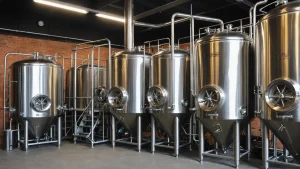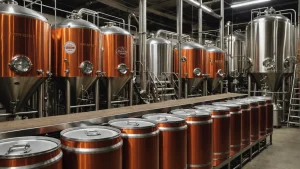Are you running a brewery that’s not as profitable as you’d like? You’re not alone. In an industry with fierce competition and razor-thin margins, many breweries struggle to break even point stay in the black.
But here’s the good news: you can turn things around by taking a hard look at your business plan and making some strategic changes.
In this blog post, we’ll walk you through 5 simple steps to maximize your brewery’s profits, from analyzing your financials to implementing effective marketing strategies.
Ready to boost your bottom line? Let’s dive in.

Lower your delivery costs by 23%
How we reduce costs:
- No delivery vehicle expenses
- Optimized local routes
- Pay-per-delivery model
- Average 23% delivery cost reduction
Maximize Your Brewery’s Profit Margins: A Step-by-Step Guide
Step 1: Analyze Your Current Financials
Analyzing your brewery’s current financial situation is crucial to understanding where you stand and identifying areas for improvement. Start by gathering your income statement, balance sheet, and cash flow statement for the past 12 months. These documents will provide a clear picture of your revenue, expenses, and overall financial health. Explore a range of brewery business plan outlines and samples to guide your financial strategy and growth. Utilize these free and premium resources to better plan the future of your brewery.
Once you have your financial statements, carefully review each line item to identify areas of high operating expenses, and low revenue. Look for any discrepancies or unusual trends that may be impacting your profitability. Pay close attention to your cost of goods sold (COGS), which includes the cost of ingredients, packaging, and labor directly related to producing your beer.
Next, calculate your current profit margin by dividing your net income by your total revenue. This will give you a percentage that represents average profit margin – how much of each dollar in sales your brewery keeps as profit. Compare your profit margin to industry benchmarks to see how you stack up against other breweries of similar size and scale.
Understanding Brewery Profit Margins
Average Profit Margin
On average, brewery profit margins range from 4% to 15%. However, profit margins for a profitable brewery can vary greatly depending on factors such as brewery size, location, and product mix.
The average gross profit margin for craft breweries is around 45%, while the average net profit margin is around 9%. Smaller craft breweries can generate annual revenues of around $1 million to $3 million, while larger breweries may exceed $10 million in revenue.
Small breweries (producing less than 1,000 barrels per year) often have lower profit margins due to higher production costs and limited economies of scale. Mid-sized breweries (producing 1,000 to 15,000 barrels per year) typically have better margins, as they can negotiate better prices with suppliers and distribute their fixed costs across a larger volume of beer.
Step 2: Optimize Your Production Costs
Once you have a clear understanding of your current financial situation, it’s time to focus on optimizing your production costs. This step involves evaluating your ingredient sourcing, streamlining your brewing process, and investing in energy-efficient equipment.
Start by reviewing your current ingredient suppliers and comparing prices with other options in the market. Don’t be afraid to negotiate better prices, especially if you’ve been a loyal customer or are willing to commit to larger order quantities. Consider joining a buying group or partnering with other local breweries to increase your purchasing power.
Next, take a close look at your brewing process to identify areas of waste or inefficiency. Are you consistently overproducing certain beers or discarding excess ingredients? Are there steps in your process that could be automated or optimized to save time and resources? Implementing lean manufacturing principles and investing in staff training can help streamline your operations and reduce costs.
Finally, evaluate your equipment and consider investing in energy-efficient options to lower your utility costs. Upgrading to more efficient boilers, chillers, and lighting systems can significantly move variable costs and reduce your energy consumption and environmental impact. While these investments may require upfront capital, they can pay off in the long run through lower operating costs and potential tax incentives.
Step 3: Adjust Your Pricing Strategy
With a streamlined production process and optimized labor costs now, it’s time to review your pricing strategy to ensure you’re maximizing your profit margins. Start by conducting market research to understand what your competitors are charging for similar products and how your prices compare.
Consider implementing a tiered pricing structure for different product lines or distribution channels. For example, you may choose to charge a premium price for limited-release or barrel-aged beers, while offering more competitive prices for your core lineup or high-volume accounts.
Don’t be afraid to adjust your prices regularly based on changes in your production costs or market trends. However, be transparent with your customers about any price increases and provide clear reasoning behind your decisions.
Pricing Strategies
A study on the Brazilian brewing industry found that pricing strategies used by breweries can have a significant impact on their corporate performance and profitability. The researchers used cointegration analysis to analyze pricing strategies. Another study on the Nigerian brewing industry examined the relevance of pricing strategies on corporate performance from 2005-2013. It found that pricing strategies were a significant factor in determining a brewery's financial performance.
Balancing Profit Margins and Customer Perception
When adjusting your pricing strategy, it’s essential to strike a balance between maximizing your net profit margins and maintaining a positive customer perception. Overpricing your products can lead to decreased sales and damage your brand reputation, while underpricing can limit your ability to reinvest in your business and maintain quality standards, or an average brewery revenue.
Aim to price your products in a way that reflects the value you provide to your customers, whether that’s through unique flavor profiles, locally sourced ingredients, or exceptional customer service. By clearly communicating your value proposition and building strong relationships with your customers, you can justify premium pricing and maintain a loyal customer base.
Step 4: Monitor and Adjust Your Financials Regularly
Maximizing your brewery’s profit margins is an ongoing process that requires regular monitoring and adjustment. Set up a system to track your financial performance on a monthly or quarterly basis, comparing your actual results to your budgeted projections.
Use this data to identify trends, spot potential issues early on, and make informed decisions about your business and a brewery’s average gross profit margin. If you notice that certain products or distribution channels are underperforming, consider making changes to your product mix or sales strategy.
Additionally, stay up to date with industry trends and best practices by attending conferences, joining trade associations, and networking with other brewery owners. By continuously learning and adapting, you can stay ahead of the curve and maintain a competitive edge in the ever-evolving craft beer market.
Step 5: Seek Professional Guidance When Needed
While these steps provide a solid foundation for maximizing your small craft brewery’s profit margins, there may be times when you need additional guidance or expertise. Don’t hesitate to seek the advice of financial professionals, such as accountants or business consultants, who specialize in the craft brewing industry.
These experts can provide valuable insights into tax planning strategies, financial forecasting, and operational best practices. They can also help you navigate complex issues such as expansion plans, equipment financing, or succession planning.
By following these steps and seeking professional guidance when needed, you can take control of your brewery’s financial future and build a profitable, sustainable business for years to come. Remember, maximizing your brewery’s profit margin margins is not a one-time task, but an ongoing process that requires dedication, adaptability, and a commitment to continuous improvement.

Metrobi is transforming beverage deliveries
Specialized solutions for beverage businesses:
- Beverage-trained drivers
- Proper handling equipment
- Peak day delivery support
- 23% average cost reduction
Boost Your Bottom Line by Increasing Taproom Sales
Create a Welcoming Atmosphere
Your taproom’s atmosphere plays a crucial role in attracting and retaining customers. To create a welcoming environment, focus on designing a comfortable and inviting space that reflects your brewery’s unique brand and story.
Start by selecting a layout for a tasting room that maximizes seating capacity while providing ample space for customers to move around comfortably. Offer a variety of seating options, such as bar stools, tables, and lounge areas, to accommodate different group sizes and preferences. Pay attention to lighting, temperature, and noise levels to ensure a pleasant experience for all visitors.
Incorporate engaging decor elements that showcase your brewery’s personality and history. Display artwork, photographs, or memorabilia that tell your brand’s story and create a sense of connection with your customers. Consider adding interactive features, such as a self-guided brewery tour or a “beer encyclopedia” wall, to educate and entertain visitors.
Develop a Unique and Diverse Beverage Menu
To appeal to a wide range of customers and increase sales, develop a beverage menu that offers variety and showcases your brewery’s unique offerings.
Start by featuring a range of beer styles, from classic favorites to innovative and experimental brews. Regularly introduce seasonal and limited-edition beers to generate excitement and encourage repeat visits. Offer beer flights or tasting paddles to allow customers to sample multiple beers and discover new favorites.
50% of Consumers Search for Bars Selling Specific Craft Beer
Half of consumers will search the internet for bars that sell specific craft beers and share pictures of craft beer online.
In addition to beer, consider offering non-beer options to cater to customers with different preferences. Craft cider, wine, and cocktails made with your brewery’s beers can attract a broader audience and increase overall sales. Collaborate with local producers to source high-quality ingredients and create unique, location-specific beverages.
Optimize Your Beer Menu Layout
Design your beer menu to be easily readable and visually appealing. Use clear descriptions and tasting notes to help customers make informed choices. Organize beers by style, alcohol content, or flavor profile to simplify navigation.
Host Events and Promotions
Hosting regular events and promotions can help attract new customers, encourage repeat visits, and boost taproom sales.
Plan a variety of events that cater to different interests and demographics. Trivia nights, live music performances, and food truck partnerships are popular options that can draw crowds and create a lively atmosphere. Collaborate with local artists, musicians, or community organizations to host exhibitions, workshops, or fundraisers that align with your brewery’s values and target audience.
Implement loyalty programs or discounts to incentivize repeat visits and higher spending per customer. Offer rewards for frequent purchases, such as a free pint after a certain number of visits or a discount on merchandise. Create time-sensitive promotions, such as happy hour specials or daily deals, to drive sales during slower periods.
Leverage Social Media and Email Marketing
Promote your events and promotions through social media and email marketing to reach a wider audience. Create engaging content, such as event teasers, behind-the-scenes videos, or customer spotlights, to build anticipation and encourage attendance. Use targeted advertising on platforms like Facebook and Instagram to reach potential customers based on their interests and location.
By implementing these strategies to create a welcoming atmosphere, develop a unique beverage menu, and host engaging events and promotions, you can significantly boost your taproom sales and improve your brewery’s bottom line.
Implement Effective Brewery Marketing Strategies
Marketing is a crucial aspect of running a successful brewery business. By implementing effective strategies, you can increase brand awareness, attract new customers, and ultimately drive sales. In this section, we’ll explore key marketing tactics and discuss how to determine an appropriate marketing budget for your brewery.
Develop a Strong Online Presence
In today’s digital age, having a strong online presence is essential for any business, including breweries. Here are some steps to establish and maintain a robust online presence:
Create a User-Friendly Website
Your website is often the first point of contact for potential customers. Ensure that your website is visually appealing, easy to navigate, and showcases your brand and products effectively. Include essential information such as your brewery’s story, beer lineup, taproom hours, and contact details.
Maintain Active Social Media Accounts
Social media platforms like Facebook, Instagram, and Twitter provide excellent opportunities to engage with your audience and share updates about your brewery. Regularly post content that showcases your brand personality, highlights new beer releases, and shares behind-the-scenes glimpses of your brewing process. Respond promptly to customer inquiries and comments to build a loyal community around your brand.
Invest in Targeted Online Advertising
To reach new audiences, consider investing in targeted online advertising. Platforms like Google Ads and Facebook Ads allow you to create ads tailored to specific demographics, interests, and locations. This ensures that your marketing messages reach the right people, increasing the likelihood of attracting new customers to your brewery.
Leverage Word-of-Mouth Marketing
Word-of-mouth marketing is a powerful tool for breweries, as personal recommendations from satisfied customers can greatly influence others to try your products. Here are some ways to leverage word-of-mouth marketing:
Encourage Customer Reviews
Encourage your customers to leave reviews on platforms like Yelp, Google, and Facebook. Positive reviews can help build trust and credibility with potential customers who are researching your brewery online. Make it easy for customers to leave reviews by providing links on your website and social media profiles.
Implement a Referral Program
Create a referral program that rewards customers for bringing in new business. For example, offer a discount or free beer to customers who refer a friend who makes a purchase. This not only incentivizes your existing customers to spread the word about your brewery but also helps attract new customers who are more likely to trust a recommendation from a friend.
Participate in Local Beer Festivals and Events
Attending local beer festivals and events is an excellent way to increase brand visibility and generate word-of-mouth buzz. Showcase your best beers, engage with attendees, and encourage them to visit your taproom. Be sure to have plenty of branded merchandise on hand, such as stickers, coasters, and t-shirts, to help spread your brand beyond the event.
Allocate an Appropriate Marketing Budget
Determining the right marketing budget for your brewery depends on several factors, including your brewery’s size, growth stage, average revenue, and overall business goals. Determining the right marketing budget for your brewery is crucial, and so is having a solid plan in place; learn how to draft an effective business plan for your brewery to guide your marketing and growth strategies.
Marketing Budget
As a general rule of thumb, small businesses typically allocate 7-8% of their total revenue to marketing.
When allocating your marketing budget, prioritize channels that have proven effective for your target audience. For example, if your customers are primarily active on social media, focus your budget on creating engaging content and running targeted ads on those platforms. Regularly review your marketing spend and adjust based on the ROI of each channel.
It’s essential to strike a balance between online and offline marketing efforts. While digital marketing is crucial in today’s world, don’t underestimate the power of traditional methods like print ads in local publications, sponsoring community events, and distributing promotional materials in high-traffic areas.
Remember, your marketing budget is an investment in your brewery’s growth. By allocating funds wisely and consistently monitoring the effectiveness of your marketing strategies, you can maximize your return on investment and ensure the long-term success of your business.
Understanding the Profitable Brewery Business Model
The Three-Tier System
The alcohol industry in the United States operates under a three-tier system, which consists of production, distribution, and retail. Breweries, as producers, must navigate this system to get their products into the hands of consumers.
In the production tier, breweries create their beers, ensuring consistent quality and adherence to regulations. They then sell their products to distributors, who make up the second tier. Distributors are responsible for storing, transporting, and selling the beer to retailers, such as bars, restaurants, and liquor stores. These retailers, in turn, sell the beer directly to consumers, completing the three-tier system.
While this system can be complex, it helps maintain a level playing field for breweries of all sizes and prevents vertical integration that could lead to monopolies. By understanding and effectively navigating the three-tier system, breweries can ensure their products reach their target audience and maintain a strong presence in the market.
Navigating State-Specific Regulations
Each state has its own set of laws and regulations governing the production, distribution, and sale of alcohol. Breweries must familiarize themselves with these rules to avoid legal issues and ensure compliance. Some states, such as California and Washington, allow breweries to sell directly to consumers through taprooms or brewpubs, bypassing the traditional three-tier system to a certain extent.
Key Revenue Streams for Breweries
To maximize profits and ensure long-term success, breweries must diversify their revenue streams. By relying on multiple sources of income, breweries can weather market fluctuations and adapt to changing consumer preferences.
The primary revenue streams for breweries include:
Taproom sales: Many breweries operate taprooms where they sell their beer directly to consumers. Taproom sales often have higher profit margins, as breweries can eliminate the middleman and control the entire sales process.
Distribution: Selling beer through distributors allows breweries to reach a wider audience and expand their brand presence. While profit margins may be lower due to the three-tier system, distribution can lead to significant volume sales.
Events and merchandise: Hosting events, such as brewery tours, beer festivals, or private parties, can provide additional revenue and help build brand loyalty. Selling branded merchandise, like t-shirts, glassware, and other accessories, can also contribute to a brewery’s bottom line.
The Importance of Taproom Sales
According to a 2023 survey by the Brewers Association, taproom sales account for an above average revenue of 24% of a brewery's total sales volume. This figure highlights the significance of taproom sales in a brewery's overall revenue mix.
Prior to the pandemic, taproom sales were growing at a rate of 15-20% around 2016, highlighting the importance of taprooms as a revenue source for breweries.
Taprooms not only provide a higher profit margin but also serve as a valuable marketing tool. By creating a welcoming and engaging atmosphere, breweries can attract new customers, gather feedback on their products, and build a loyal fan base. Taprooms also allow breweries to experiment with new beer styles and gather real-time customer insights before committing to larger-scale production and distribution.
Assessing the Viability of a Brewery Investment
Investing in a brewery requires thorough research and analysis of market demand, financial health, and management expertise
Common risks include market saturation, changing consumer preferences, and regulatory challenges
Successful brewery investments can yield attractive returns, but realistic expectations are crucial
Factors to Consider When Investing in a Brewery
Before investing in a brewery, it’s essential to conduct a comprehensive analysis of the local market demand and competition. This involves researching the target audience, assessing their preferences, and identifying potential gaps in the market. By understanding the local market dynamics, investors can determine whether there is sufficient demand for the brewery’s products and if the business can differentiate itself from competitors.
Another crucial factor to consider is the brewery’s current financial health and growth potential. Investors should review the brewery’s financial statements, including revenue, expenses, and cash flow, to assess its profitability and sustainability. Additionally, evaluating the brewery’s growth strategy, expansion plans, and potential for scalability can provide insights into its long-term viability.
The management team’s experience and expertise play a significant role in the success of a brewery investment. Investors should assess the team’s track record, industry knowledge, and ability to execute the business plan effectively. A well-rounded management team with a proven history of success in the brewing industry can instill confidence in the investment’s potential.
Risks and Challenges of Investing in a Brewery
While investing in a brewery can be lucrative, it’s important to be aware of the potential risks and challenges. One common pitfall is market oversaturation, particularly in areas with a high concentration of craft breweries. As more breweries enter the market, competition intensifies, making it harder for individual breweries to stand out and maintain market share. Investors should carefully evaluate the level of competition and the brewery’s unique selling proposition to mitigate this risk.
Another challenge is the evolving nature of consumer preferences. The craft beer industry is known for its rapid innovation and ever-changing trends. What may be popular today could quickly become outdated tomorrow. Breweries that fail to adapt to changing consumer tastes risk losing market share and profitability. Investors should assess the brewery’s ability to innovate, experiment with new styles, and stay ahead of industry trends.
Some Challenges
47% of consumers are most likely to associate craft beverages with unique flavors. If a brewery's goal is growth, it will need to spend time developing distinctly differentiated beverages and brands in this highly competitive market.
42% of people believe that craft beer has higher quality ingredients than other beers, and 41% believe craft beer requires more attention and time in the production process.
50% of consumers will search the Internet for bars that sell specific craft beer and will share pictures of craft beer online. 30% of craft beer drinkers will be influenced by the design of the brewery's website.
Regulatory and legal considerations also pose significant challenges for brewery investors. The alcohol industry is heavily regulated, with strict licensing, labeling, and distribution requirements. Breweries must navigate a complex web of federal, state, and local regulations, which can be time-consuming and costly. Investors should thoroughly understand the regulatory landscape and ensure that the brewery has the necessary permits and compliance measures in place.
Potential Returns on Brewery Investments
Despite the risks and challenges, successful brewery investments can yield attractive returns.
Contribution to Economy
According to the Brewers Association, the craft beer industry contributed $79.1 billion to the U.S. economy in 2018, with an average annual growth rate of 13.6% between 2008 and 2018.
This growth has attracted significant investment interest, with many breweries experiencing impressive returns on investment (ROI).
One example of a successful brewery investment is Ballast Point Brewing Company. In 2015, Constellation Brands acquired Ballast Point for $1 billion, representing a significant premium over its prior valuation. The acquisition highlighted the potential for high returns in the craft beer industry, particularly for well-established and rapidly growing breweries.
However, it’s important to have realistic expectations when investing in a brewery. While some investments may yield exceptional returns, the industry average ROI is more modest.
Average Gross Margin
According to a study by the National Beer Wholesalers Association, the average gross margin for a craft brewery is around 30-35%, with net profits ranging the average brewery profit margin from 5-10%.
Investors should carefully consider these industry benchmarks when evaluating potential returns and setting expectations.
Is a Brewery a Good Investment?
The answer to whether a brewery is a good investment depends on various factors, including the specific brewery, market conditions, and the investor’s risk tolerance. While the craft beer industry has experienced significant growth in recent years, not all breweries are equally profitable or sustainable.
According to a survey by Craft Brewing Business, the average annual salary for a brewery owner is around $75,000, with some earning a few thousand dollars or significantly more depending on the size and success of their operation. However, owning a brewery also comes with substantial costs, including equipment, ingredients, labor, and distribution expenses. Investors must carefully evaluate the brewery’s financial projections and profitability to determine if the potential returns justify the investment.
Average Salary
the average annual salary for a brewery owner in the United States typically ranges from $50,000 to $100,000 or more. However, this can vary significantly depending on several key factors.
It’s also worth noting that the brewery industry is not immune to economic downturns or market shifts. During the COVID-19 pandemic, many breweries faced significant challenges, with on-premise sales plummeting due to lockdowns and restrictions. While some breweries adapted by focusing on packaged beer and online sales, others struggled to stay afloat. Investors should consider the brewery’s resilience and ability to adapt to changing market conditions when assessing its long-term viability.
Ultimately, investing in a brewery requires careful due diligence, market research, and a thorough understanding of the risks and rewards involved. By considering the factors outlined above and setting realistic expectations, investors can make informed decisions about whether a brewery investment aligns with their financial goals and risk tolerance.
Case Studies: Successful Brewery Business Models
Stone Brewing, founded in 1996 in San Diego, California, has grown to become one of the largest craft breweries in the United States. Their success can be attributed to several key factors, including a focus on high-quality, bold-flavored beers, quality beer, and a strong brand identity that resonates with craft beer enthusiasts.
One of the most significant contributors to Stone Brewing’s financial success has been their partnership with Zengistics, a logistics and supply chain management company. By outsourcing their distribution, inventory management and logistics operations to Zengistics, Stone Brewing has been able to focus on their core competencies of brewing and marketing, while ensuring efficient and cost-effective delivery of their products to retailers and customers.
Zengistics Partnership Benefits
Streamlined distribution processes, reducing costs and improving efficiency
Access to advanced technology and data analytics for optimized supply chain management
Ability to scale operations quickly and effectively to meet growing demand
Example 2: Breakside Brewery
Breakside Brewery, based in Portland, Oregon, has achieved success through a combination of unique business strategies and adaptability in the face of challenges. One of their key strengths has been their ability to create a diverse portfolio of beers that appeal to a wide range of consumers, from classic styles to experimental and collaborative brews.
During the COVID-19 pandemic, Breakside Brewery demonstrated their agility by quickly shifting their focus to the local grocery stores and store sales. By leveraging their strong relationships with local retailers and investing in packaging and marketing efforts, they were able to maintain a steady revenue stream despite the closure of taprooms and restaurants.
Breakside Brewery’s Revenue Streams
On-premise sales at taprooms and brewpubs
Off-premise sales through grocery stores, bottle shops, and online platforms
Contract brewing and private label partnerships
Lessons Learned from Successful Breweries
By examining the case studies of Stone Brewing and Breakside Brewery, several common themes and best practices emerge that can be applied to optimize any brewery’s business plan:
Focus on product quality and consistency to build a loyal customer base
Develop a strong brand identity that resonates with your target audience
Embrace partnerships and collaborations to expand your reach and capabilities
Diversify your revenue streams to mitigate risks and capitalize on opportunities
Remain agile and adaptable in the face of challenges and changing market conditions
Further Reading and Resources
To dive deeper into the strategies and tactics employed by successful breweries, consider exploring these resources:
“The Craft Beer Revolution: How a Band of Microbrewers Is Transforming the World’s Favorite Drink” by Steve Hindy
“Brewing Up a Business: Adventures in Beer from the Founder of Dogfish Head Craft Brewery” by Sam Calagione
“Brewery Operations Manual” by Tom Hennessy
By studying the experiences and lessons learned from thriving breweries, you can gain valuable insights to refine your own business plan and set your brewery on the path to long-term success.
Brewing Success: Putting Your Plan into Action
Maximizing your brewery’s profits requires a strategic approach that encompasses financial analysis, cost optimization, pricing adjustments, and effective marketing. By reviewing your business plan and implementing these five simple steps, you can create a roadmap to success in the competitive craft beer industry. Wondering how to strategize for success? Learn the essentials of a strong brewery business plan and the steps to craft it for your brewery’s prosperity.
Focus on creating a welcoming taproom atmosphere, developing a unique beverage menu, and hosting engaging events to drive sales and build a loyal customer base. Invest in your online presence and leverage word-of-mouth marketing to expand your reach and attract new customers.
Are you ready to take your brewery to the next level? Start by scheduling a meeting with your team to review your current business plan and identify areas for improvement. Assign responsibilities and set achievable goals to ensure steady progress toward your objectives.
Remember, success in the brewery industry requires adaptability, creativity, and a commitment to delivering exceptional products and experiences to your customers. Embrace the challenges, celebrate your victories, and never stop striving for excellence.
What’s one step you can take today to optimize your brewery’s performance and profitability?


























